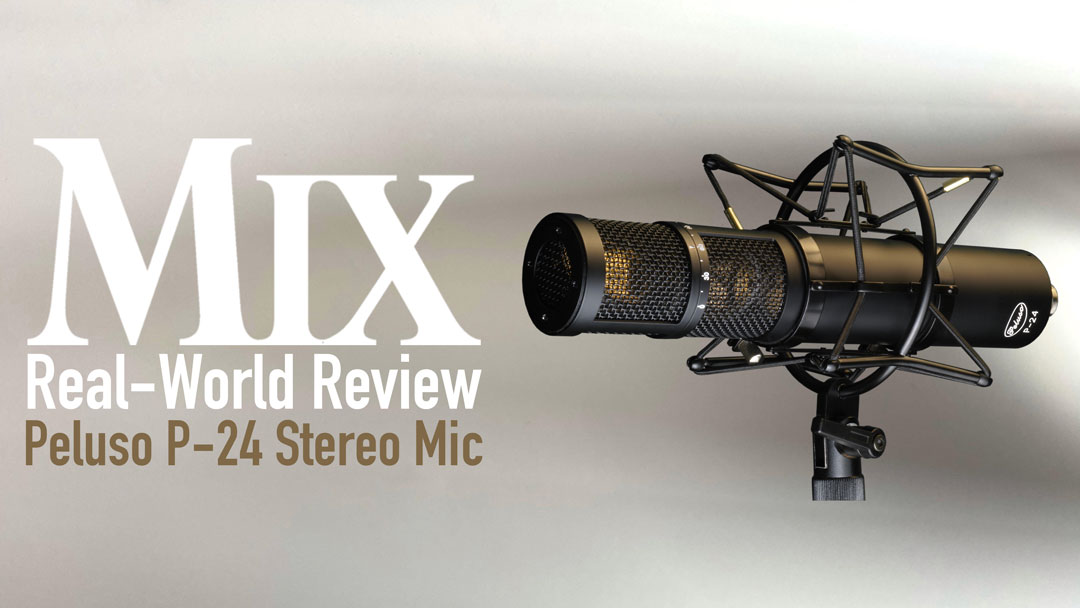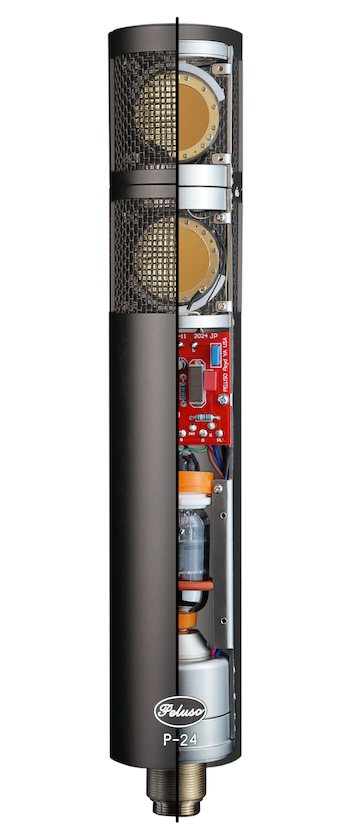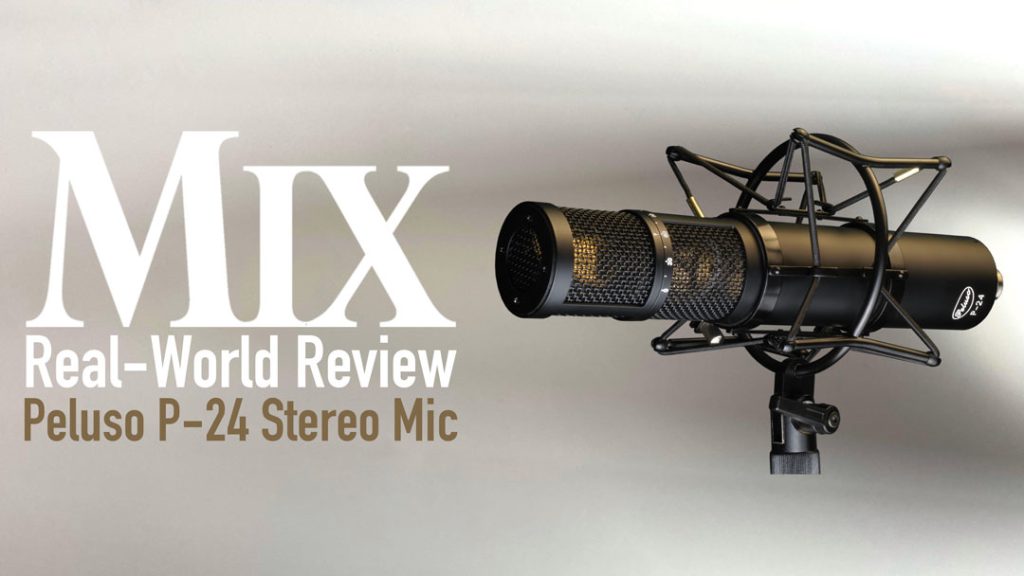
| MIX VERDICT: PELUSO P-24 MIC |
| THE TAKEAWAY: “The Peluso P-24 makes it easy to experiment with any of the classic stereo recording techniques using a single microphone.” |
| COMPANY: Peluso Microphone Lab • www.pelusomicrophonelab.com PRICE: $3,999 USD MSRP PROS: • Big-sounding, large-diaphragm stereo microphone useful for many sources. CONS: • It’s a bit heavy. |
New York, NY (June 30, 2025)—The Peluso P-24 is the result of a two-year collaboration to design and build a large-diaphragm, stereo microphone that closely follows the design philosophies of AKG’s legendary C24. For those who dig deep, the P-24 uses two gold, edge-terminated, dual-diaphragm 32mm P-CK-12 capsules that are historically accurate and interchangeable with the vintage AKG CK12 brass capsule.
Same as the vintage C24, the P-24 uses a single dual-triode 6072AM with one triode section for each capsule. Sourced from EI NOS or Svetlana, the 6072A is a military-grade version of a 12AY7 but with matched triode halves and a lower noise specification. There are no solid-state output buffer/amps used, and the internal circuit board is hand-wired in-house. There are two T14/1 output transformers, made by Tamura, and both are enclosed in a mu-metal can with a shield divider between them to reduce crosstalk.
The two capsule assemblies are positioned one above the other, same as the C24. The upper capsule can be rotated in 15-degree increments up to 180 degrees, relative to the fixed, bottom capsule. The upper capsule turns on a hollow, vertical, axial tube that routes the connecting wires to the capsule. The Peluso logo at the base of the mic marks the front of the mic and when the upper capsule is rotated to 0 degrees, it is physically aligned with the bottom capsule, both facing front.
Dreamtonics Synthesizer V Studio 2 Pro — A Mix Real-World Review
The P-24 weighs 2.3 pounds and measures an impressive 10.6 inches long. The kit includes a 16-foot, multi-core connecting cable, shockmount, power supply and a large, foam-lined carrying/travel case. The power supply has a pair of nine-position polar pattern switches for remotely selecting the patterns individually for the upper and lower capsules, called Output 1 and Output 2.
Any polar pattern from omni-directional to figure-eight can be set for the top and bottom capsules individually. In this way, any stereo microphone technique is possible. You may use it as mid/side with a front-facing cardioid and a side-facing figure-eight, an X-Y coincident pair with the two cardioids set to any angle, or as a Blumlein pair using two crossed figure-8 patterns.

STARTING OFF WITH GUITAR
My first use of the P-24 was to record an acoustic guitar in a small iso booth using the Blumlein technique. The P-24 is a big and heavy mic, so I brought in a large floor stand and boom with sandbags placed on the base. I positioned it about 1 meter (39 inches) in front of the guitar, right where the neck joins the body.
I used a pair of Wolff Audio S1P “Tutti” mic preamps set to about 35 dB of gain and fed two mono audio tracks (not a single stereo track) into Pro Tools. This produces a wide and expansive sound in a realistic and spatial presentation. Moving the P-24 closer in and slightly reducing the mic pre gain did increase the bottom end (due to proximity) and close down the stereo width. I liked the focus.
I also liked the P-24 for recording acoustic guitar with vocal at the same time. I used the X/Y stereo pattern on a Martin D-28, adding another X/Y for the vocal. The guitar’s low frequencies were present and dynamic. However, recording vocals with a stereo mic can be problematic if your singer moves about in front of the mic. I could hear timbral changes of the voice in the stereo field—especially on headphones. Having the facility to change polar patterns quickly proves invaluable for experimenting with different stereo techniques when recording everything from orchestral instruments to ensembles to drum kits.
REALISTIC, POWERFUL DRUM SOUND
For drums, I placed the P-24 overhead and centered equidistant between the snare and the floor tom, in front of and just above the drummer’s head. I tried X/Y cardioids first, then Mid/Side when I wanted control over the stereo spread later on, and also the super-wide Blumlein technique. All three worked wonderfully, and there was no clipping heard, even when my drummer played hard and loud.
While configured in an X/Y coincident pair and with the drummer playing, I changed the patterns from two cardioids to two figure-8 patterns. I did this in real time, right on the downbeat of a chorus. I just loved the widening out of the stereo drum imaging. In Blumlein, the imaging greatly changed with more specific localization and detail of the kit’s components—toms, L/R cymbals, hi-hat, etc.
Discover more great stories—get a free Mix SmartBrief subscription!
I was only able to do this “cowboy” trick because there were no pops, clicks or gaps heard when changing the pattern rotary switches. If the multi-core mic cable were longer, the power supply could be located in the control room to do this from behind the console. A longer cable could also be useful for orchestra miking and/or hanging from the studio’s ceiling. (A custom-length cable up to 100 meters long can be ordered.)
While placed horizontally over the kit, it can sometimes be hard to tell where the capsules are aimed. I started by turning the whole mic in the shock-mount so that the bottom half was aimed as I wanted. Then I used the white pointer/cursor on the side of the top capsule assembly to rotate it to where I wanted—but I confirmed the capsules by having my assistant “snap” the upper and lower capsules. Works great!
AND, OF COURSE, VOCALS
Recording lead vocals affords the opportunity to use both capsules at the same time with both set to cardioid. I fed their outputs to separate signal chains. Again, I used the S1P for capsule 1, followed by a single channel of an API 529 stereo limiter compressor. Capsule 2 was connected to a Retro Instruments (all-tube) Powerstrip Channel.
I had clean limiting/compression from capsule 1 for the verses, and the Retro Power Strip gave me a mellow tube compression for the much louder-sung chouses. Because the singer was very quiet in the verses, this worked out well. While mixing, I managed to make the transition (from verse to chorus and back) sound seamless.
The Peluso P-24 makes it easy to experiment with any of the classic stereo recording techniques using a single microphone. There’s no worry about phase and levels, as you might get when using two separate mics, and your recordings will take on a three-dimensional quality immediately. Recommended highly.

